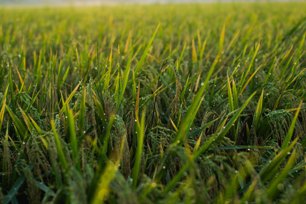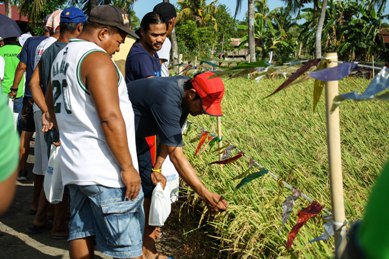 Carrageenan plant growth promoter (PGP), extracted from red edible seaweeds, proved to be beneficial for Roger Cornelio, a farmer cooperator in Bay, Laguna. He shared his experience in using the technology during a Farmers’ Field Day held in his farm.
Carrageenan plant growth promoter (PGP), extracted from red edible seaweeds, proved to be beneficial for Roger Cornelio, a farmer cooperator in Bay, Laguna. He shared his experience in using the technology during a Farmers’ Field Day held in his farm.
Cornelio tested the technology in his 6,000 square meter farm in Bay, Laguna. He has observed that his rice yield has increased from 2.4 tons last year to 3.9 tons this year or an increase of 62.5%.
Cornelio said that through applying carrageenan PGP, they harvested earlier at 100 days after transplanting, instead of the standard harvesting time of 120 days.
“We observed that each panicle was robust, the grains were uniform, and there were minimal and almost no unfilled grains. The rice plants were also disease-free, uniform in height, and did not lodge even after a strong rain,” said Cornelio.
A total of 4.5 L of carrageenan PGP was used in the farm, which he combined with three bags of inorganic fertilizer. Carrageenan PGP was applied 10 days after transplanting, followed by the second application two weeks after the first application, and 26 days after second application.
 Other farmers who attended the field day were impressed by the technology. Melchor Arcillas, farmer for 16 years and President of the Bay Farmers Federation, said that the carrageenan PGP should be affordable so that farmers could avail and benefit from the technology. On the other hand, Celso Caniedo, also a farmer in Bay, was impressed after seeing the overall plant stand in Cornelio’s farm. Caniedo said that using the technology might give him more income. Lastly, Oscar Panisales, a 50-year-old rice farmer, said that he would gladly recommend carrageenan PGP to his fellow farmers once it becomes available in the market.
Other farmers who attended the field day were impressed by the technology. Melchor Arcillas, farmer for 16 years and President of the Bay Farmers Federation, said that the carrageenan PGP should be affordable so that farmers could avail and benefit from the technology. On the other hand, Celso Caniedo, also a farmer in Bay, was impressed after seeing the overall plant stand in Cornelio’s farm. Caniedo said that using the technology might give him more income. Lastly, Oscar Panisales, a 50-year-old rice farmer, said that he would gladly recommend carrageenan PGP to his fellow farmers once it becomes available in the market.
Carrageenan PGP, developed through modified irradiation technology, is being tested in Bulacan, Nueva Ecija, Laguna, and Iloilo. It has been found to increase rice yield from 15-40%. The technology makes the rice stem stronger and improves resistance to lodging. It also promotes resistance to rice tungro virus and bacterial leaf blight. Further, it is environment-friendly as it has no harmful effects on natural enemies or beneficial insects. The technology also proved to be compatible with farmers’ practice.
The technology is developed through the funding of the Philippine Council for Agriculture, Aquatic and Natural Resources Research and Development of the Department of Science and Technology (DOST-PCAARRD) and implemented by the DOST-Philippine Nuclear Research Institute (DOST-PNRI), Philippine Rice Research Institute (PhilRice), and the National Crop Protection Center of the University of the Philippines Los Baños (UPLB-NCPC).
